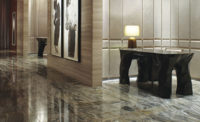Among numerous outdoor changes to the Saint Louis Art Museum was that to the museum's highly focal courtyard/roadway. Those involved in this aspect of the museum project included the general contractor, McCarthy Building Co., Inc. of St. Louis, MO; architect Powers/Bowersox of St. Louis; landscape architect Spaid/SWT Associates of St. Louis; stone installer John Smith Masonry of St. Louis; and Laticrete International, installation products manufacturer. “In the past we've installed granite curbs but never an entire street,†said John J. Smith of the John J. Smith Masonry Co. “The pavers utilized in the project were all different sizes in order to create a special designed pattern. The museum, the museum's location and the area's history make the project noteworthy and unique.â€
“The Saint Louis Art Museum and the courtyard's statue of King Louis IX are major focal points in Forest Park as well as in the city of St. Louis,†stated Mike Sharamitaro of McCarthy Building Co. “Our building site was the location for the 1904 World's Fair. This project just has such great historical significance.â€
Bill Bowersox of Powers/Bowersox detailed the project as being not only unique but extremely predominant. “This was a plaza/street basically,†said Bowersox. “The courtyard is such a heavily traveled space that the area had to be designated like a highway. Laticrete Systems were essential for a quality granite installation. The museum wants this installation to last.â€
Carnelian red and black granite from Cold Spring Granite was utilized for this project in sizes of 1 x 4 feet, 6 x 6 inches and 4 x 4 feet. The 6- x 6-inch pavers were installed in the sidewalks, 1- x 4-foot strips were arranged in a running pattern in the main entry area and the 4- x 4-foot pavers made up the large plaza area. Approximately 38,000 square feet of pavers were utilized.
“Granite was chosen for the richness and durability it adds to the front of the Saint Louis Art Museum,†stated Sharamitaro. “The designers felt that concrete or stamped concrete would not provide the same feel or life expectancy as granite.â€
Laticrete specified a “full mortar bed†designed with Laticrete 3701 Mortar Admix fortified with Laticrete 226 Thick Bed Mortar to achieve the setting bed for the pavers. In addition, Laticrete 4237 Latex Thin-Set Mortar Additive with Laticrete 211 Crete Filler Powder was also utilized along with Laticrete Tri-Poly Fortified Sanded Grout on this project.
